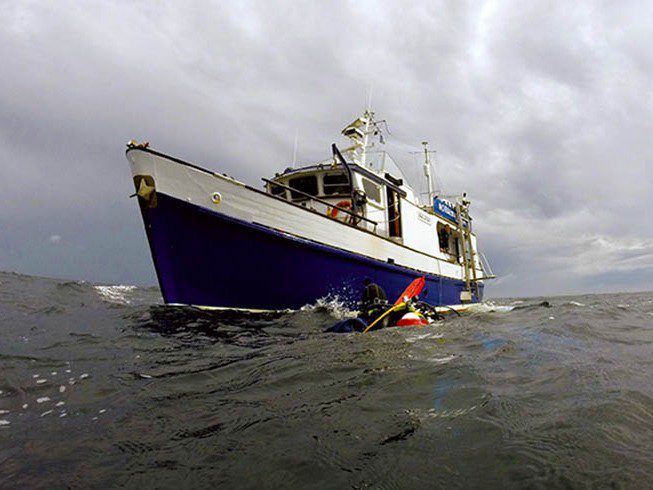LIVEABOARD DIVER
40 Dives 40 Dishes
The private yacht Judith Parks, built in Ireland in 1968, used to divide its time sailing out of Grimsby and around the Mediterranean. In 1988 it was bought as a family business, renamed Salutay, and converted into a diving vessel.
In 1989 Salutay sailed to Northern Ireland to start liveaboard dive charters around the Isle of Man, Rathlin Island and Strangford Lough. This continued until it sailed to the South Coast of England in 2014 to pursue new grounds.
Salutay is owned by Al Wright, who was one of the UK’s first trimix divers, and his wife Freda, who is not only an accomplished trimix- and cave-diver but also a trained chef, for which many divers have had cause to be grateful.
Now the couple have brought out a book based around their long-established UK liveaboard, and the title tells the tale.
Here are two of the diving stories and a taster recipe from 40 Dives 40 Dishes…
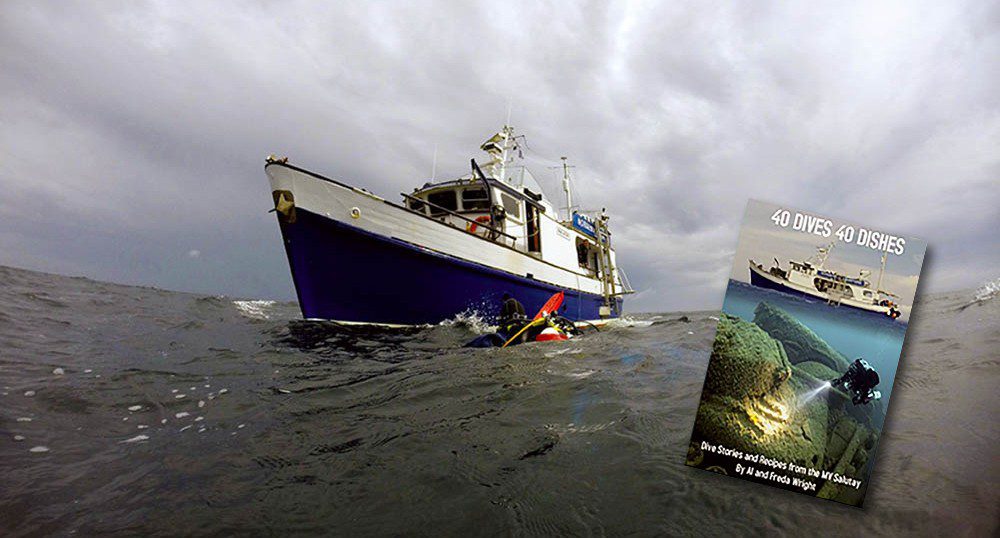
THE EMPIRE HERITAGE
by Al Wright
when you discover a shipwreck and dive it for the first time, there is a great deal of anticipation. All sorts of thoughts run through your head. How intact is it? Is it upright or capsized? Has it been dived before? Will the bell be there?
But nothing prepared me for what I was about to find when I first dived the Empire Heritage. Not in my wildest dreams did I expect to find a cargo of Sherman tanks!
Already in 1994 I had located and found HMS Audacious and had also dived the RMS Justicia for the first time.
I knew where the Empire Heritage and the mv Pinto were. They were less than a mile apart and had been located in the 1960s by HMS Bulldog during an Admiralty survey. As far as I was aware, neither had ever been dived.
The Empire Heritage was built in 1930 in Newcastle upon Tyne. She was formerly called the Tafelberg and had operated as a whaling factory ship.
The German U-boat U-482 torpedoed her en route from New York to Liverpool, and she sank with the loss of 113 lives.
At the time, she was carrying a cargo of 16,000 tons of fuel oil and 1900 tons of deck cargo, including the Sherman tanks.
The Salutay was chartered for a neap week in July and we were lucky to have a light south-westerly wind and very little swell. We quickly found the wreck. She was resting at 67m and sat more than 6m proud of the seabed. One of her loading “goal-post” masts was as shallow as 47m.
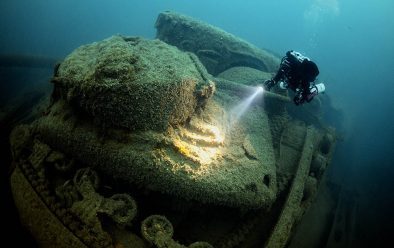
Again, my dive buddy was Dave Rigg, and again, for this dive, we were on our usual bottom gas of 17/40 trimix, with nitrox 36 and pure oxygen for decompression.
As we went down the shot, the wreck came into view at around 45m and the first things I spotted between the shoals of pollack were the goal-post loading masts, and a variety of strange objects scattered on the deck and seabed.
We touched bottom and trimmed out, then I swam towards the hold.
Sticking out from it was a turret with a short gun-barrel. I looked around and saw another upturned Sherman tank with its caterpillar tracks clearly visible.
Looking around, I noticed that several more tanks were scattered on the seabed, along with a truck.
Dave and I checked our gauges and swam forward over an accommodation module and towards the bridge. I spotted a large telegraph and made for that, while Dave headed over to the left.
The telegraph was jammed under a large beam and freeing it would require some work. I started shifting debris.
Then I heard a noise and looked over to where Dave was frantically gesturing at me to come over. He had found the ship’s bell. It was securely attached to a 6ft goose-neck bar and was sticking out from beneath another girder.
Dave bashed the nut and bolt securing the bell, but to no avail. I managed to move the girder with my crowbar but the steel bar was too heavy. We needed a hacksaw, and we didn’t have one.
Our bottom time was running out, as was our bottom gas after all this exertion. So we dragged the bell and bell fixtures under a nearby steel plate so that they were out of sight. We began our ascent and, at 33m, switched to nitrox 36.
At 27m, we deployed our deco markers and line and started the slow process of decompression. After 106 minutes in the water we climbed the ladder back onto the Salutay and immediately began planning to return to the Empire Heritage, properly tooled up this time, and recover the bell.
the bell recovery
i had a week to recover the bell before the next Salutay charter. Dave could not stick around, so it was up to me.
I called Simon Bamford, whose RIB I had used earlier in the year for the first Audacious dive. He and his RIB were both available, as was Kim Cox, another trimix diver.
We launched from Lough Swilly and were soon scooting across the wave-tops at 30 knots. There was a definite air of excitement and anticipation among our small team.

We arrived at the wreck-site and Simon dropped the shot as close to the bridge as he could. The plan was that I would go in first, unclip the shot, send it up with a lift-bag, then swim the shotline to the bell location and secure it.
Then I would start work with a large hacksaw on the steel pipe, while Simon tied the RIB into the line.
I dropped in and was soon on the bottom. Luckily, the shot was not far from the bell, so I quickly bagged up the shot and swam the shotline over. I dragged the bell and steel pipe from under the plate where we had stashed it, and began working on it with the hacksaw.
After 25 minutes the bell was nearly free but it still needed another five minutes’ work.
I was getting low on bottom mix and had reached the end of my planned bottom time, so I had to ascend.
As we had planned, after 30 minutes Simon came down past me on the shotline to finish the job.
Ten minutes later, while I was still decompressing, the bell flew by me towards the surface, attached to a lift-bag, clipped into the shotline. Mission accomplished.
When I surfaced I removed my kit, climbed into the RIB and there it was, the Empire Heritage’s bell. I scraped some of the shells and barnacles away and made out the inscription “TAFELBERG”, its original name.
I started cleaning it up, while Kim took my Aquazepp for a tour of the wreck and Simon decompressed on the shotline.
On our return to port, I declared the bell to the Receiver of Wreck for posterity and, the following week, the Salutay returned to the Empire Heritage, with a group of technical divers called “the Bandits”, and we recovered the bridge telegraph. It had been a memorable wreck-diving season.
Appeared in DIVER December 2018
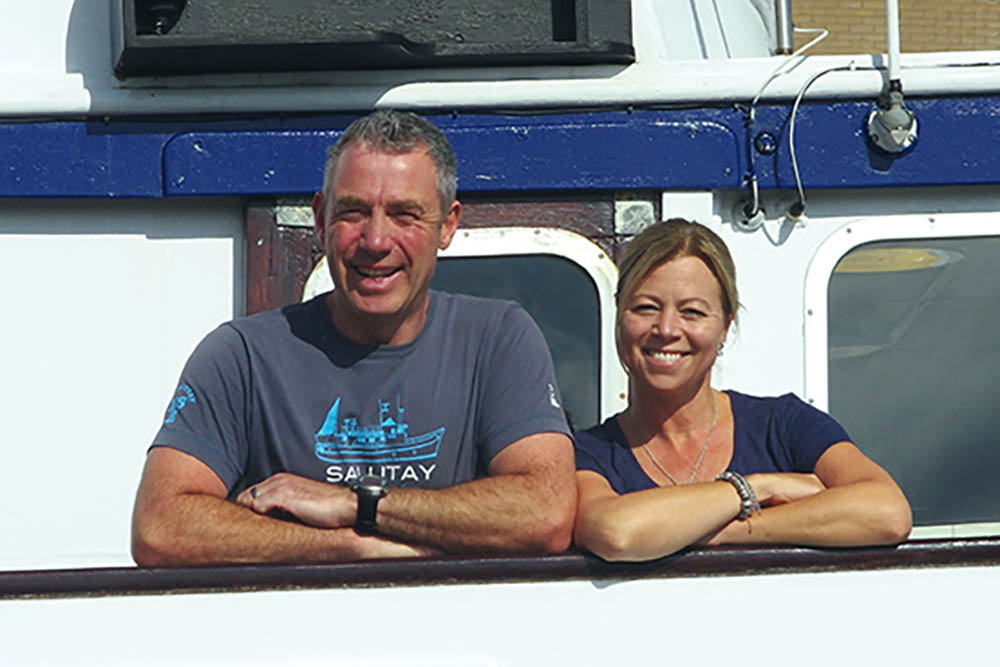
ST KILDA
by Freda Wright
st kilda is an isolated archipelago 40 miles west-northwest of North Uist in the North Atlantic Ocean. It contains the westernmost islands of the Outer Hebrides of Scotland, and I have lost count of the times we have visited this incredible island on the Salutay.
It is always a magical feeling when you arrive, because so often the weather conditions are not kind enough to get there, let alone stay.
However, the first time I went was probably my most memorable. Al invited me to join a 10-day trip in 1998, as the boat was not full and had spaces.
So I jumped at the chance, managing to get time off work last minute. I was working for a car-rental company at the time and had a very nice boss.
It took 36 hours to get from Port Patrick to St Kilda without stopping.
I didn’t expect that!
Arriving at St Kilda, the weather conditions were moderate, with a fresh south-easterly wind causing the Salutay to roll from side to side, which meant that our anchorage for the night in Village Bay was not the most comfortable.
I remember the next morning, the sausages were cooking in the oven for breakfast, the bacon was under the grill and the eggs were on the side (on a non-slip mat) ready for frying. Al said to me: “Could you keep an eye on the bacon?
I’m just going to check that the dive-equipment is ready for the first dive.”
Before I knew it, I had served a full breakfast for 10 divers, which wasn’t easy as a few fried eggs slid out of the pan across the cooker as Salutay took a roll.
Once breakfast was over, I started to feel a little seasick. Then it dawned on me. Where was Michael, the cook from the last trip that I’d been on?
I later found out he was on the Ocean Youth Trust boat that week, and Al and Danny, a good friend from his Plymouth University days, were meant to be doing the cooking.
Luckily, Al’s mum had prepared wholesome homemade food for the trip in advance, which was how they operated at the time, so it was just a matter of heating prepared meals that had been frozen. Guess who ended up doing that? No such thing as a free holiday, I thought!
trouser rock
My first dive was on Trouser Rock at 30m up to 10m, and I jumped in to visibility of 30-40m. Countless seals were darting around and biting my fins and the walls were just covered in a carpet of jewel anemones of every colour imaginable!
There were crayfish in the crevices of the rocks and every other underwater critter you could imagine.
The site is called Trouser Rock because the shape of the rock formation is exactly the same as Wallace’s trousers in the Wallace & Gromit movie. First we dived to the bottom, then went through a triangle-shaped cave hole, swam right the way up the trouser leg and basically came out at the crotch! Which is where we met all the playful seals.
The dive lasted for 70 minutes, and I was on a single 15-litre cylinder with a 3-litre pony of air. We dived different dive-sites during our time there, and somehow I ended up cooking for the rest of the trip. Luckily my seasickness improved, and I enjoyed the remaining dives at St Kilda.
It was on this trip that we got the chance to dive the only wreck at St Kilda, the steamship ss Manor in 55m.
Ken, the skipper at the time (an ex-navy CPO), shotted the wreck. Danny Burton was on board and Al dived with Danny as he was on a rebreather, while I dived with Danny’s wife, Caroline.
On the way down the shotline, I saw one of our divers coming back up it with a bell under his arm and a seal (of which he was completely unaware) swimming up behind him!
Was I hallucinating? Or was I already narked? No, what I saw before my eyes was real. I looked back at Caroline, whose eyes were as wide as mine.
We OK’d each other, carried on down the shot and had a fantastic dive.
When Caroline and I came back to the surface, there was an altercation on board between two of our divers about whose bell it was.
Ken had to break up the fight, and Al said the bell had to go to the museum on the island, which is what happened.
The following night in the Puff Inn pub in Village Bay, we held a ceremony and handed the bell over to the National Trust warden for safekeeping. To keep the peace between the two divers, we anchored for the night in Glenn Bay, at the opposite end of the island from Village Bay.
Because the wind was in the south-east, it was more comfortable here, with less rolling around at anchor.
The next morning we dived the Saw-cut. This is a narrow cut, about 1.3m wide and 25m deep, which penetrates 60m into the island of Doon.
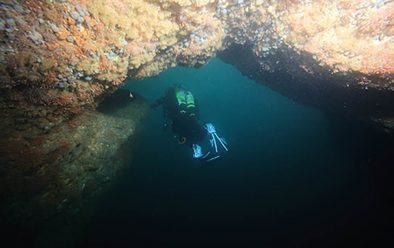
The walls are sheer and coated with anemones, soft coral and sponges. We had to make sure we didn’t get swept right through the cut and come out the other side. Otherwise, Ken the skipper would be very angry, as this would make for a difficult pick-up.
Luckily, I was with Al and he made sure we turned around at the right point to return to where we started and get back on board safely. Then we dived Scarbhstac arch on Boreray, which was an incredible dive, as the arch was so big and wide, with currents running along the side of the cave wall.
Once you came through the arch, you just finned along the magnificent wall, covered in jewel anemones of every colour imaginable.
Our last dive was at Boreray with caves and tunnels and endless clear blue water. It was then time to head back to the mainland. It was quite rough, so we had sandwiches along the way, but the weather improved and we had a comfortable passage back to Port Patrick, diving along the way to break up the journey.
I remember another trip back from St Kilda. It was an amazingly calm day and the divers had been on deck watching out for wildlife when I called them in for lunch. I brought Al’s lunch up to the bridge, and just as he stood up a minke whale leapt out of the water, breaching!
It was an absolutely magnificent sight, and boy, did we scream! The divers came rushing out of the saloon with cameras in hand. The whale breached again and again. Rohan Holt managed to get a photo of it in the distance.
We had dinner tied up alongside at Lochmaddy Isle of North Uist. It was Fish & Chip Night. I think we can say we are the only British liveaboard to have a deep-fat fryer with two large baskets.
I cooked the breaded fish (or mackerel straight from the sea if we had caught some that day). The chips were deep-fried and were always to die for.
We generally tried to do a scallop-dive on Fish & Chip Day, so you can imagine it was always a feast, served with crushed peas and rocket.
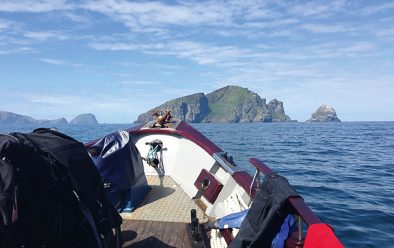
NOW READ THE BOOK…
Sandsmedia Publishing
ISBN: 9781717270788
Softback, 166pp, 15x23cm, £19.95 (Amazon) or buy through the Salutay website for £16 plus £2 P&P.
For more on the liveaboard visit salutay.co.uk
DIVER-CAUGHT SURF & TURF SCALLOPS
(serves two)

METHOD Clean your scallops. If you don’t know how, ask a fellow-diver. Wrap six of them in bacon and use a cocktail stick to hold the bacon in place.
_Leave the other six unwrapped. Put the butter onto a baking tray and melt it in the oven for a minute. Take the tray out and scatter the scallops on it, then sprinkle them with the Cajun sea spice (see below) and season well.
_Bake in a pre-heated oven at 180*C, gas mark 4, for about 15 minutes until the bacon looks crispy and the scallops are just cooked. You can always test one without the bacon when nobody is looking!
_Serve sprinkled with freshly chopped parsley and a wedge of lemon or two. I usually serve these on Fish & Chip Night if we have caught some. This recipe is just amazing and incredibly simple, especially if you have made my Cajun sea spice recipe in advance.
_I remember I first saw scallops in their shells in 1990 at a hotel where I was working as a chef. We had fresh fish delivered every day, and on the hand-written invoice were the words “diver-caught scallops”. I was so impressed. I was just learning to dive and hoped one day to catch my own,
TOP TIP Don’t add too much Cajun sea spice, or it will spoil the delicate taste of the scallops. Just a little sprinkle is enough to really enhance the taste of these little bites of deliciousness. The reason I only wrap half the scallops is because too much bacon can overpower the dish.
CAJUN SEA SPICE

METHOD Using a coffee grinder, grind all the ingredients together. Pour into a jam jar. Use a clean paintbrush to get all the spices out of the grinder.
TOP TIP I use this spice mix for lots of my recipes. It’s a great mix to have on board and it’s so versatile. I use a tablespoon of each instead of a teaspoon when I want to make a bigger batch.
